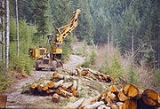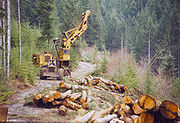
Swing yarder
Encyclopedia

Forestry
Forestry is the interdisciplinary profession embracing the science, art, and craft of creating, managing, using, and conserving forests and associated resources in a sustainable manner to meet desired goals, needs, and values for human benefit. Forestry is practiced in plantations and natural stands...
equipment
Machine
A machine manages power to accomplish a task, examples include, a mechanical system, a computing system, an electronic system, and a molecular machine. In common usage, the meaning is that of a device having parts that perform or assist in performing any type of work...
used for pulling logs from the woods to a logging road with cables
Wire rope
thumb|Steel wire rope Wire rope is a type of rope which consists of several strands of metal wire laid into a helix. Initially wrought iron wires were used, but today steel is the main material used for wire ropes....
. The swing yarder is also known as a grapple yarder.
In any logging
Logging
Logging is the cutting, skidding, on-site processing, and loading of trees or logs onto trucks.In forestry, the term logging is sometimes used in a narrow sense concerning the logistics of moving wood from the stump to somewhere outside the forest, usually a sawmill or a lumber yard...
operation, it is necessary to transport the harvested tree from the stump to a landing for transport to market (usually on a truck). If the ground is relatively flat it may be possible to transport the tree or logs cut from the tree on a wheeled or tracked machine. However if the ground is too steep for the operation of such machinery, it is common practice to rig some sort of a cable system for moving the wood. The swing yarder is one of several varieties of machines that have been used for this purpose.
The swing yarder has several drums to pull in the cables. The cables run up an angled boom and then to the far side of a setting. By using two cables set up like a clothes line, the rigging can be pulled out and logs can be pulled across a logging setting where the trees have been previously felled. This machine is most suitable for steep ground where it is difficult to access the logs with other machinery. Swing yarders can also be used in flatter areas with lighter loads.
While there are various rigging options, the most common one uses a grapple that can be lowered onto a logs and closed via the cable system. Using a grapple avoids the need for people in the setting to attach chokers to the log. Choker setting as a profession is a very dangerous occupation.
The main difference between a swing yarder and a tower yarder is that the upperworks is mounted on a large slewing
Slewing bearing
To "slew" means to turn without change of place; a "slewing" bearing is a rotational rolling-element bearing that typically supports a heavy but slow-turning or slow-oscillating load, often a horizontal platform such as a conventional crane, a swing yarder, or the wind-facing platform of a...
bearing
Bearing (mechanical)
A bearing is a device to allow constrained relative motion between two or more parts, typically rotation or linear movement. Bearings may be classified broadly according to the motions they allow and according to their principle of operation as well as by the directions of applied loads they can...
. This bearing permits the boom and cable system to be 'swung' across a setting without relocating the machine. An experienced operator uses timing and cable tension to swing the grapple
Grapple (tool)
A grapple is a hook or claw used to catch or hold something. A ship's anchor is a type of grapple, especially the "grapnel" anchor.A throwing grapple is a multi-pronged hook that is tied to a rope and thrown to catch a grip, as on a parapet or branch of a tree...
to the desired location. In practice, however, the main benefit of a swinging machine is that once the logs are yarded up to the machine, they can be swung to the side and landed. This allows the machine to be positioned in a small area such as on a road, and to land (set down) the logs on the road behind (or in front of) the machine. By contrast a tower has no options on where to set the logs---so the tower has to be positioned back from the break of the hill so as to leave a landing area on the downhill side of the machine, the logs can only be pulled up to near the tower and then lowered to the ground making it necessary for a shovel (log loader) to also be present to remove the logs once landed. Implicitly a swing machine does not need to be as tall as a tower machine particularly in steep ground because the swing machine can be set right up to the 'edge' of the steep ground while the tower must be set back from the 'edge' to allow landing space.

